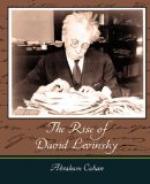|
This section contains 4,616 words (approx. 16 pages at 300 words per page) |

|
SOURCE: "Cahan's Rise of David Levinsky: Archetype of American Jewish Fiction," in Judaism: A Quarterly Journal, Vol. 22, No. 3, Summer, 1973, pp. 278-87.
In the following essay, Vogel contends that The Rise of David Levinsky became the archetype for later fiction in the same genre.
Some years ago, in a reconsideration of Abraham Cahan's 1917 novel, The Rise of David Levinsky, Isaac Rosenfeld declared, "Levinsky [is] the essential Jewish type of the Dispersion." The truth of this assertion is underlined, it seems to me, by the rehearsal of some essential elements of theme, characterization, and method in later American Jewish fiction. My purpose here is to explore the ways in which The Rise of David Levinsky is archetypal—archetypal, not in the sense of racial memory, but in the sense of community experience during the three generations since the flood of East European Jewish immigration in the 1880's. Nor do I...
|
This section contains 4,616 words (approx. 16 pages at 300 words per page) |

|


